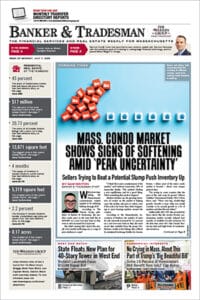Emboldened by one of the strongest office markets in the country, Boston-based Mugar Enterprises is making another attempt to develop an 18-acre Arlington parcel into an office park, company officials confirmed last week. Various efforts to build on the property during the past two decades have met with opposition from both state officials and Arlington residents.
Despite the lack of success to date, company principal Peter Mugar said last week that his firm is proposing a pair of 150,000-square-foot buildings for the property. DiMella Shaffer Assoc. of Boston has designed the five-story buildings, which would be accessed via the abutting Route 2, while an engineering firm has been retained to assess site conditions.
“We have been working on it,” Mugar told Banker & Tradesman. While acknowledging the lengthy stalemate over developing the property, Mugar said his company feels conditions are optimal at present to get the project off the drawing boards.
“We feel that we have certain rights, and if we meet all the criteria from an environmental and engineering standpoint, there’s no reason we shouldn’t be able to move ahead,” Mugar said.
A number of retail and office concepts have been proposed without success for the parcel, which is located across from the Alewife MBTA station and the Arthur D. Little headquarters. According to Mugar, the last serious effort to develop the property came in the mid-1980s when an office use was quashed after state transportation officials refused to allow vehicles to enter and exit onto Route 2. Abutting residents have also fought against the plan, and Arlington planning official Kevin O’Brien said last week that opponents proposed at town meeting earlier this year that the property be preserved as open space, either through an outright donation of the land by Mugar or via a sale.
O’Brien said residents are concerned about traffic congestion, even though the park would not be accessible through local streets. While maintaining there has been “tacit support” from some in the community who would like to generate commercial revenues from the site, O’Brien said the opposition has been far more vocal in pushing its side.
“The neighborhood definitely doesn’t want to see it developed,” O’Brien said, adding that, “they are pretty well organized.”
Nonetheless, O’Brien said the town has indeed been approached by Mugar, and said he believes that a formal application is in the works. Along with state approvals, Mugar would have to appear before the Arlington Redevelopment Board and the town’s Zoning Board of Appeals, from which it requires a special permit to develop in a flood plain.
“There’s a lot that needs to be done,” said O’Brien. “It’s going to be quite a challenge for them to [gain approval].”
Cambridge Market
As daunting as the hurdles appear to be, Mugar may be inspired by the potential rewards such a project would bring were they successful. Commercial real estate specialists said they believe the space would serve as an attractive option for office tenants, especially those who have been shut out by the lack of opportunities to be found in the abutting Cambridge office market.
“If they could get it approved, that would be a spectacular location,” said Mark Winters, a managing director of Cushman & Wakefield in Boston. “It’s right off Route 2, it has great visibility, and there’s nothing [available] out there right now.”
Mid-year office market statistics bear that viewpoint out, with Timothy Parsons of Spaulding & Slye placing the overall vacancy rate for Cambridge at a miniscule 0.1 percent. That number essentially signals that no space is available in the city, considered a strong market due to the presence of Harvard University and the Massachusetts Institute of Technology, as well as its close proximity to downtown Boston.
Parsons said the vacancies range from 0 percent in East Cambridge to 0.1 percent in Harvard Square and 0.7 percent in the Alewife district. Following net absorption of 130,039 square feet in the first half of 2000, Cambridge now has just 13,706 square feet vacant in a market totaling 10.9 million square feet.
Correspondingly, rental rates for Cambridge have escalated dramatically, with Cushman & Wakefield placing the direct average asking rent at $50.87 per square foot, up from $41.36 per square foot at year end 1999. East Cambridge, considered the strongest of the city’s three submarkets, has an average per-square-foot asking rent of $54, compared to $34.50 in Harvard Square and $50.59 in Alewife. Winters described the rental growth over the last three years as “unbelievable,” having increased from an overall rate of $30.41 in 1997.
In terms of the Arlington property, Peter Mugar could not provide a precise timetable, but said the company is committed to getting the project underway. As with Winters, Mugar predicted that the park would generate considerable interest from office tenants. He added that his firm has retained Finard & Co. of Burlington to assist in the permitting process.






